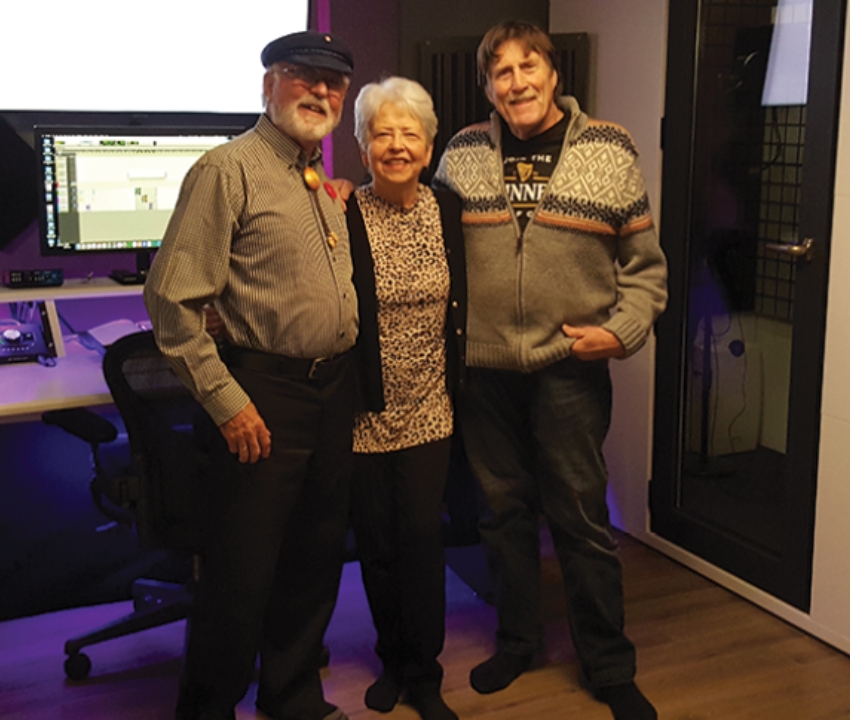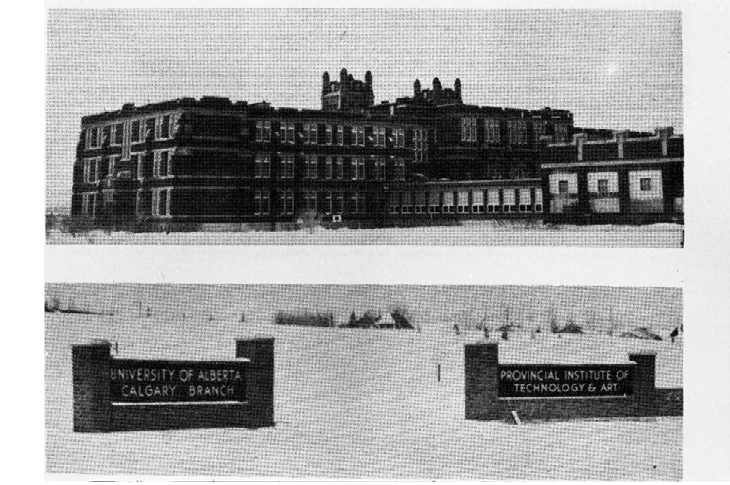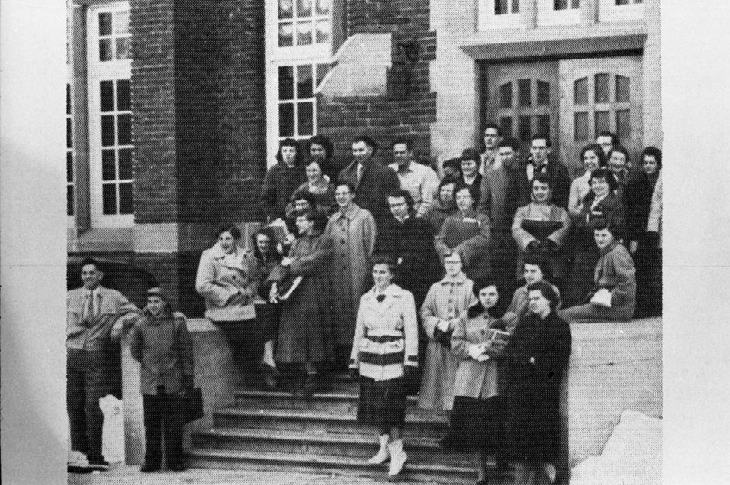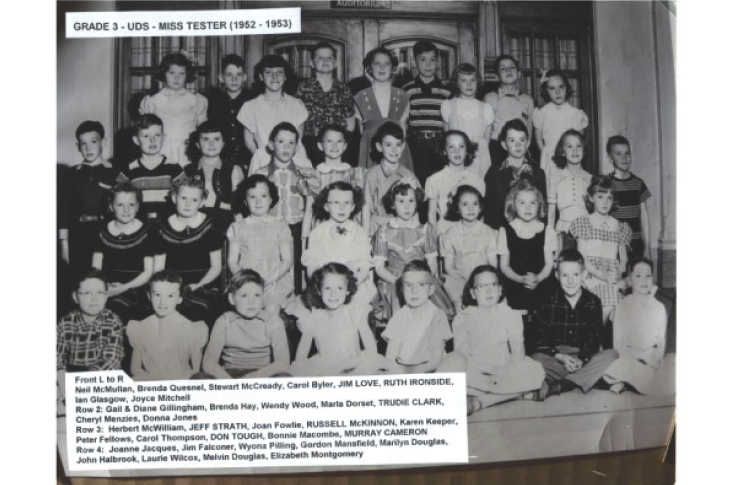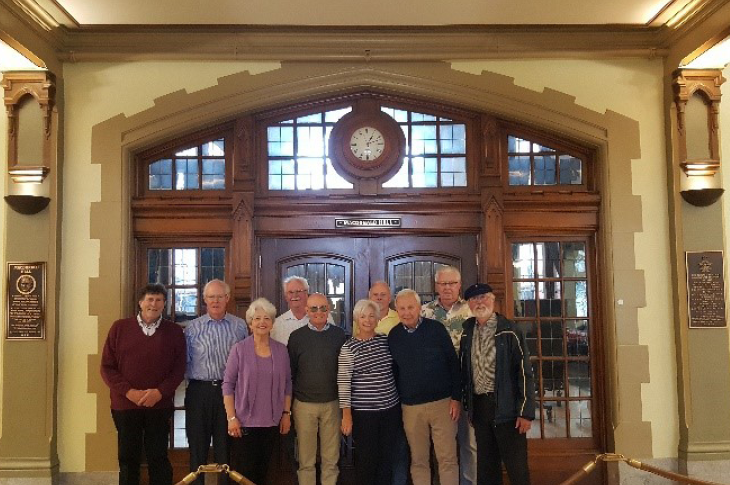About this episode
After the Second World War, the Calgary Normal School (a training school for primary and secondary school teachers) returned to the west wing of Heritage Hall as the Calgary Branch of the University of Alberta’s Faculty of Education University Demonstration School (UDS). Until 1955, youngsters from all around the area came to elementary school in the grand building, where they would not only learn lessons in mathematics, English and science, but also what happens when you stick your tongue on a freezing cold door handle.
Listen as three UDS alumni who have been friends for more than 70 years — Murray Cameron, Ruth Hindle (Ironside) and Brock Smith — recount childhood memories from their days at UDS.
(Intro) DR. DAVID ROSS: What is possible with a steadfast and bold vision. Welcome, welcome to SAIT!
(0:15) FEMALE VOICEOVER: A red brick and sandstone building looms large on Calgary's north hill, complete with twin towers, Gothic arches, and gargoyles. They've stood watch over the city for a hundred years. Now, this is Heritage Hall, the heart of the Southern Alberta Institute of Technology known as SAIT and we are celebrating the lessons of the past 100 hundred years since students first walked through its doors. One hundred years of innovation, pushing boundaries and leading by example. One hundred years of getting SAIT students up to speed for a rapidly changing new world. Join us and learn from the stories whispered from these walls celebrating 100 years of Heritage Hall. What lessons would we learn if only these halls could talk?
(1:11) RON TARRANT: SAIT has always stood as a beacon of education, not only in Calgary and not only in Alberta and not only in Canada, but also as a respected institute around the world. I mean, just think all the countless international students who have traveled from afar to learn here in these hallowed halls. I mean, let's be honest SAIT didn't just become a leader in higher learning overnight. As they say, the best education starts in the early years. First you learn to walk, then you run. But no running in the halls!
At one time, the University Demonstration School (UDS) in Heritage Hall helped develop life's most impressionable minds children. <child laugh> You think the towering stone walls on campus are intimidating to an adult? Imagine young, small children walking this massive campus. I mean, it must have felt like Hogwarts and you know, maybe that comparison's not too far off. After all, ask a child what they want to be when they grow up and you'll get a variety of answers from a radio producer to lawyer, nurse, to architect, to farmer UDS and Heritage Hall, and SAIT has helped all these dreams come true and more for multitudes of children. And I gotta say, that feels pretty magical to me.
(2:23) MURRAY CAMERON: Well, what more could you ask for, than to have three friends here that we have been chums for over 70 years now? We still gather along with some of our other classmates right from grade one and it all started when we met in Heritage Hall.
My name is Murray Cameron and started off school of course, over at UDS, which is in the Heritage building, now called SAIT. Ruth Ironside and I were in the same grade, right from the beginning and went right through to high school. Actually, Ruth was the valedictorian in Crescent Heights High School when we got there. And Brock, of course, was a couple of grades behind us, but he lived on the same street as I did. And we all played around and it was a very close-knit community and we all walked to school together and everybody visited on the way.
Some of our early memories of course are the things that I did in school in grade three, a bunch of us got class jobs and mine happened to be our social convener for our grade three class. So one of the projects I did, I took the whole class down and organized and I did have help from members that I cannot remember who they are, but we went to Riley Park for a picnic and we've got photographs of this. And we did the three-legged race and the gunnysack race and all sorts of things. And, and we all took a picnic lunch down and just had a great time. What are your early recollections, Ruth?
(4:02) RUTH IRONSIDE: There was no playground at the school. It was just barren, but the boys sometimes would play a bit of football. We would play baseball girls or boys, or mixed. The girls on the pavement in front of our grade nine class, and on the west end, where we would have a lacrosse ball and toss that ball up the corner of the building, because it wasn't a square corner, it was nicely marked with bricks on each side and a flat area. And that took hours, you know, every week that we would play there. That was how we played.
(4:41) MURRAY CAMERON: Our principal at the time was Mr. Burt, Oswold Miller, B. O. Miller, quite the character. What do you remember about him Ruth?
(4:51) RUTH IRONSIDE: He was very tall, bald, middle-aged, perfect speech. You respected him. If he's watching you'd better behave. He was also kind and he taught me how to write after Miss Tester in grade three said I would never be a nice writer. I showed him in the end that he had taught me well, <laugh>. You ever end up in that Principal’s Office?
(5:19) MURRAY CAMERON: Oh, on occasion. Not very often because as it happened, Mr. Miller came to our house once a week for piano lessons. And so, my mom taught him piano. Consequently, it was actually good for me because I smartened up in a lot of ways.
(6:36) BROCK SMITH: My name is Brock Smith, and I went to UDS from 1953. I graduated out of SAIT in 1955. Excellent memories of being there. I remember the polished concrete floors in there. You could slide a mile on wet feet. I remember that they had stuffed animals in showcases all along both sides of the hallway in there. I had Miss McKill for Grade 1. Delightful lady, not according to my report card, but I thought she was delightful. She took the entire class at the end of the year down to Glenmore Park for an end of Grade 1 party in outing, which I don't think people can do today. My Grade 2 teacher, Miss McMurtry invited the entire class to her house over on fourth street for a year-end graduation party. And I thought that was wonderful.
I remember it was January, 1955 and Stewart Obey said to me, he said, if you put your tongue on the door handle of the west block there, he said, it'll stick. And I thought, wow, no, I don't think so, because I got a hot tongue. So, I stuck it on there and bang. It was stuck to the thing. Uh, oh! And I was sitting there trying to yank on it without losing too much skin. And Mary Lou Mackey came over, a ninth grader who lived next door to me on Present Road. And she said, I'll go get some boiling water. So, she left and, and I thought I don't need boiling water, but my greatest fear was the ninth graders because they never opened a door in the building, they booted it. And I figured if one of those booted the door, it would’ve caved my head in. So, I just ripped my tongue off. And my mom said I was the nicest, quietest little fella for about two and a half months that had ever lived in her house.
I really enjoyed the first two grades that I had up at UDS there because they had cloak rooms and my behavior was probably not as good as it could have been, because I spent most of the year in the cloak room for Grade 1 and Grade 2, which allowed me to go through all the other kids’ lunches and find the good stuff, which I did. And I even got the chance to do that at Rosedale School when they built it because Miss Tester had a cloak room in hers. So, I had three years of good eating.
My sister remembered the recess bell. It was a hand bell that somebody rang outside the doorway of the west block. She remembered the banging all the blackboard brushes on the bricks and stonework all around the west door. Miss Tester's room had a diorama and other artifacts from native peoples in there. There was a teepee and fire and paintings and things. And it was really interesting to look at.
There was a rumour afloat that there was indeed a hockey rink out behind that Heritage Hall. But I don't recall that it was, I recall that there was a, a slight hill to the west rise with some bushes on it. And we played in the bushes with snowballs and running around in a soccer ball out on that small hill, which is, is now a parking lot, but it was great fun back when I was in Grade 1 and 2.
(8:45) MURRAY CAMERON: The library, to my recollection, it wasn't a very big library, but it had a spiral staircase that went up into the tower at the very top of Heritage Hall. And it seems to me, there was a very small room up there and it did have a chair and a little table, from my recollection…
(9:02)RUTH IRONSIDE: The Grade 9 class was also on the main floor. I remember the boys coming in from, you know, probably a phys ed when we were maybe going to the library, maybe going to the gym. And these big boys saw these little kids and they come running and put the hand on the head of the small child and jump over them. It was quite funny.
(9:27) MURRAY CAMERON: One of my favorite recollections of Heritage Hall is all the music brought forth mostly by, of course, Mr. Miller, our principal and Miss Genie, our Grade 5 teacher.
(9:38) BROCK SMITH: You know, Mr. Miller would, would run the assemblies in there and all the seven, eight, and ninth graders sitting up in the balcony of the old Heritage Hall. And the rest of us ‘nutheads’ were sitting on the floor and he would bang away in a piano and we'd do God Save the Queen and Oh Canada. And then he'd launch into a lovely Alberta and I love best. And, it would, it would, descend from there into something that I probably wasn't that interested in.
(10:06) MURRAY CAMERON: He taught us some of the old folk songs or they maybe they weren't that old, but they were the folk song of the day. He was also the French teacher. So, we some songs in, you know, Alouette and what have you, so we could get to be semi-bilingual at the time as well.
(10:23) RUTH IRONSIDE: The one thing that I do remember that was sort of noteworthy for the city, the Governor General Vincent Massey came to town to visit. He’d only been in the job for about a year and he came to Heritage Hall and although he didn't come to see us at in the auditorium, it was probably more for the actual technical school. We all gathered on the south lawn, outside the towers to see him, and so that was one V.I.P. that came to our school.
(11:04) RON TARRANT: Continue the journey through SAIT's historical past visit sait.ca/alumni for more episodes.
Listen now
Photo gallery
Photographs courtesy of SAIT Archives and Ron Tarrant. Feature image of Murray Cameron, Ruth (Hindle) Ironside, and Brock Smith.
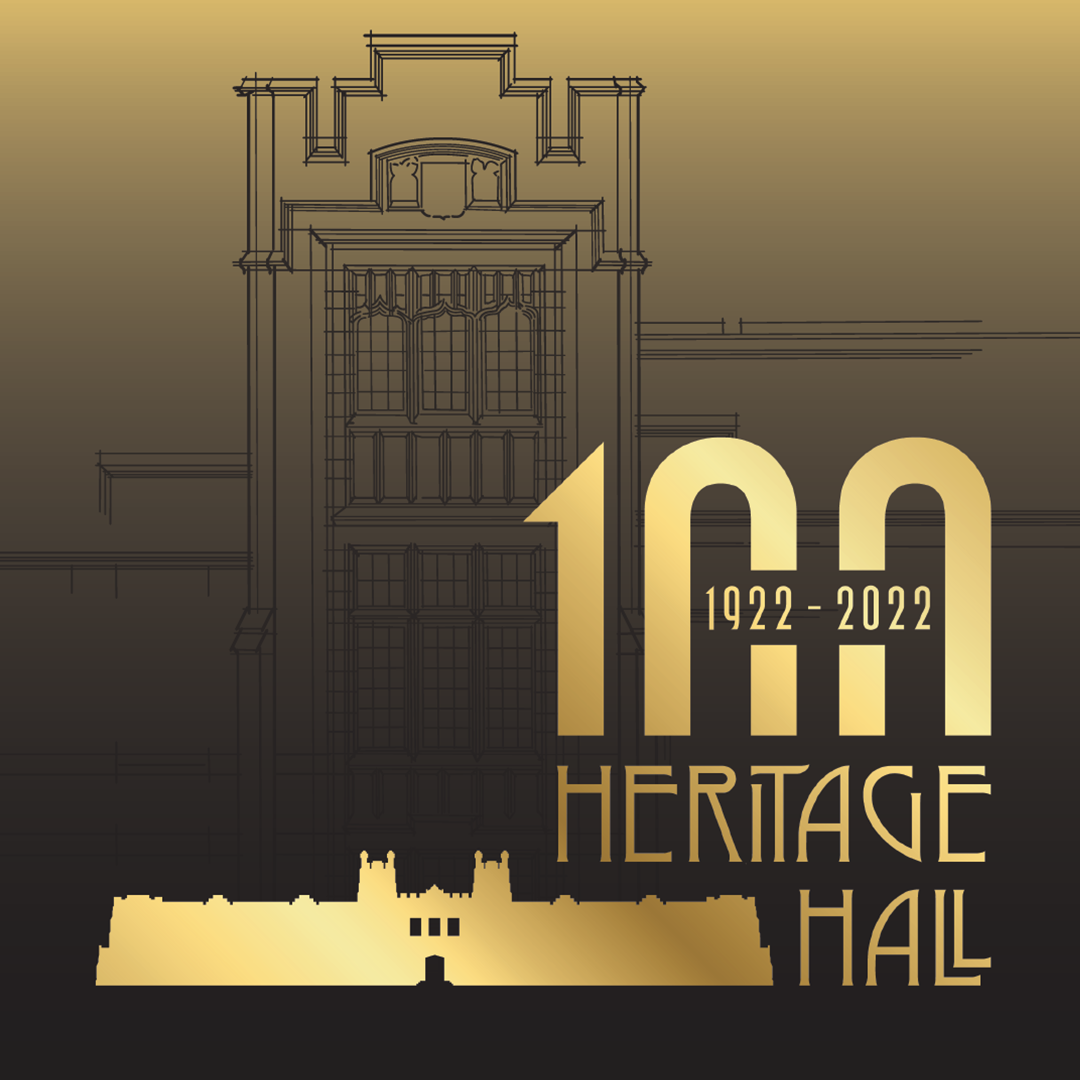
Celebrating 100 years of history
To commemorate the first 100 years of the iconic Heritage Hall building, we released an intriguing eight-episode audio series and dedicated the Spring 2022 issue of LINK magazine that share the memories and stories from SAIT alumni, employees and neighbours.

Oki, Âba wathtech, Danit'ada, Tawnshi, Hello.
SAIT is located on the traditional territories of the Niitsitapi (Blackfoot) and the people of Treaty 7 which includes the Siksika, the Piikani, the Kainai, the Tsuut’ina and the Îyârhe Nakoda of Bearspaw, Chiniki and Goodstoney.
We are situated in an area the Blackfoot tribes traditionally called Moh’kinsstis, where the Bow River meets the Elbow River. We now call it the city of Calgary, which is also home to the Métis Nation of Alberta.
